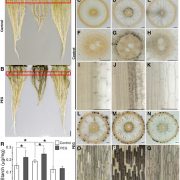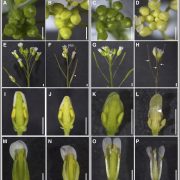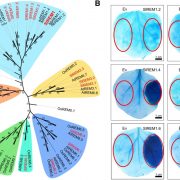
An Intrinsically Disordered Protein Interacts with the Plant Cytoskeleton
Plant Physiology, Plant Physiology: On The InsideIntrinsically disordered proteins lack a defined three-dimensional structure but often contain a simple amino acid composition with repeated sequences that provide the basis for multivalent intermolecular interactions. Because of their unique structural flexibility, conformational adaptability, and…

A Peptide Hormone Receptor Controls Seed Size and Yield
Plant Physiology, Plant Physiology: On The InsideLeucine-rich repeat receptor-like kinases (LRR-RLK) are one of the largest gene families in plants. Research over the past decade has implicated LRR-RLKs and their selective interactions with secreted peptide hormones in a myriad of developmental processes. A conserved LRR-RLK with a burgeoning list…

Remorin and Plant Death
Plant Physiology, Plant Physiology: On The InsideProgrammed cell death (PCD) in plants is closely associated with a wide variety of biological processes, including cell differentiation, aleurone layer formation, tapetum degradation, leaf and fruit resistance, pathogen invasion and abiotic stresses. Plant PCD is a complex genetically programmed mechanism,…

Roots, Bacteria, Ethylene, and Rhizosheath Formation
Plant Physiology, Plant Physiology: On The InsideThe rhizosheath, the sticky part of the rhizosphere, is the layer of soil that adheres to roots upon excavation of the root system. The stickiness of the layer arises from mucilage and other substances secreted by roots, soil microbes or both. Rhizosheaths preferentially form in drier soil and are…

Durotropic Growth of Pollen Tubes
Plant Physiology, Plant Physiology: On The InsideUpon germination, the vegetative pollen cell forms a long tubular protrusion, the pollen tube, which rapidly elongates through the pistil and transports the enclosed immobile sperm cells toward the egg and the central cell for double fertilization. To reach the female gametophyte, growing pollen tubes…

Chlamydomonas and Vitamin B12
Plant Physiology, Plant Physiology: On The InsideNutrient amendment experiments suggest that B12 limits phytoplankton growth in many aquatic ecosystems. Eukaryotic algae cannot synthesize B12 and must instead obtain it from certain B12-producing prokaryotes. In many algae, B12 is required as a cofactor for the B12-dependent Met synthase enzyme (METH),…

Small Secreted Peptides of a Model Legume: a Database
Plant Physiology, Plant Physiology: On The InsidePlant small secreted peptides (SSPs) have emerged as an important class of regulatory molecules involved in plant growth, development, plant-microbe interactions, and stress tolerance. SSPs are typically encoded within preproteins of 100–250 amino acids, that are subsequently processed into shorter…

Cineole Synthesis in Kiwifruit
Plant Physiology, Plant Physiology: On The InsideOver 80 volatile organic compounds (VOCs) have been described in ripe kiwifruit (Actinidia spp.), with the most important odor-active compounds typically being straight-chain esters and C6 aldehydes and alcohols. Another odorant proposed to be important in the flavor of ‘Hort16A’, one of three…

New Insights into Tomato Ripening
Plant Physiology, Plant Physiology: On The InsideFruit ripening results in changes in pigmentation, enhanced aromas and flavors, and flesh softening. The ripening process involves massive changes in gene expression patterns. RIPENING INHIBITOR (RIN) is a transcription factor that plays a major role in regulating fruit ripening in tomato (Solanum lycopersicum).…

